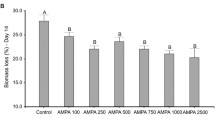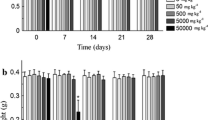Abstract
An HPLC method has been developed to determine adenosine triphosphate (ATP), adenosine diphosphate (ADP) and adenosine monophosphate (AMP) in eggs and juveniles ofHeterodera schachtii in cysts extracted from soils. ATP levels in eggs and juveniles were highly correlated with the numbers of hatched juveniles in root diffusate (r=+0.92) in series of soil samples originating from field trials testing different doses of fumigant nematicides. The measured ATP concentrations in the cysts explained 59% of the sugar-yield reduction on these fields, which was similar to the value based on the hatching test. After fumigation, carried out in a laboratory experiment, ATP and the adenylate energy charge, (AEC=ATP + 0.5 * ADP)/(ATP + ADP + AMP), decreased greatly within a few days. In a series of greenhouse trials in whichH. schachtii had been parasitized severely byVerticillium clamydosporium and other antagonists, there were significant correlations between the numbers of hatched juveniles and the ATP content of the cysts (r=+0.85), and between the percentages of hatched juveniles and the AEC (r=+0.75). The HPLC method is faster than conventional methods and can be used to establish the viability ofH. schachtii field populations affected by soil fumigation or egg pathogens.
Similar content being viewed by others
References
Atkinson DE and Walton GM (1967) Adenosine triphosphate conservation in biosynthetic regulation. J. Biol. Chem. 242: 3239–3241
Atkinson DE (1968) Citrate and the citrate cycle in the regulation of energy metabolism. Biochem. Soc. Symp. 27: 23–40
Atkinson HJ and Ballantyne AJ (1977a) The adenosine triphosphate content of cysts ofGlobodera pallida andG. rostochiensis as a possible quantitative estimate of field populations. Ann. appl. Biol. 87: 407–414
Atkinson HJ and Ballantyne AJ (1977b) Changes in the adenine nucleotide content of cysts ofGlobodera rostochiensis associated with the hatching of juveniles. Ann. appl. Biol. 87: 167–174
Chapman AG, Fall L and Atkinson DE (1971) Adenylate Energy Charge inEscherichia coli during growth and starvation. J. Bact. 108: 1072–1086
Coolen WA (1979) Methods for the extraction ofMeloidogyne spp. and other nematodes from roots and soil. In: Lamberti F and Taylor CE (eds) Root-knot Nematodes (Meloidogyne Species), Systematics, Biology and Control (pp. 317–329) Academic Press, New York
Crump DH and Kerry BR (1987) Studies on the population dynamics and fungal parasitism ofHeterodera schachtii in soil from a sugarbeet monoculture. Crop Protection 6: 49–55
De Nie LH and Van der Poel PW (1991) Uniforme methode voor gewichtsbepaling, monstername en monsteronderzoek van suikerbieten in Nederland. CSM, Amsterdam
Hoestra H (1978) Effect of benomyl on the potato cyst nematodeHeterodera rostochiensis. Neth. J. Pl. Path. 82: 17–23
Maas PWTh and Heijbroek W (1982) Biology and pathogenicity of the yellow beet cyst nematode, a host race ofHeterodera trifolii on sugar beet in the Netherlands. Nematologica 28: 77–93
Payne RW (1994) Genstat 5 Release 3 Reference Manual. Oxford University Press, Oxford
Steele AE, Toxopeus H and Heijbroek W (1982) A comparison of the hatching of juveniles from cysts ofHeterodera schachtii andH. trifolii. J. Nematol. 14: 588–592
Storey RMJ and Atkinson HJ (1979) Measurement of the adenosine triphosphate content of cysts ofGlobodera rostochiensis as a method for assessing the efficacy of fumigant nematicides. Ann. appl. Biol. 93: 299–304
Storey RMJ (1982) The ATP method for rapid assessement of the efficacy of a single application of a fumigant againstGlobodera spp. in field soils. Ann. appl. Biol. 101: 93–98
Storey RMJ and Mark RJ (1983) Screening for resistance to potato cyst nematodes using bioluminescent photometry. Ann. appl. Biol. 103: 321–326
Strehler BL (1974) Adenosine-5′-triphosphate and creatine phosphate. Determination with Luciferase. In: Bermeyer HU (ed.) Methods of Enzymatic Analysis, 2nd edition, Vol. 4 (pp. 2112–2126) Academic Press, New York
Viarengo A, Secondini A, Scoppa P and Orunesu M (1986) A rapid HPLC method for determination of adenylate energy charge. Experientia, 42: 1234–1235
Author information
Authors and Affiliations
Rights and permissions
About this article
Cite this article
Huijbregts, A.W.M., Gijssel, P.D., Munning, R.G. et al. Estimation of the viability ofHeterodera schachtii field populations by measuring ATP, ADP and AMP contents of eggs and juveniles using HPLC. Eur J Plant Pathol 102, 277–282 (1996). https://doi.org/10.1007/BF01877966
Accepted:
Issue Date:
DOI: https://doi.org/10.1007/BF01877966




